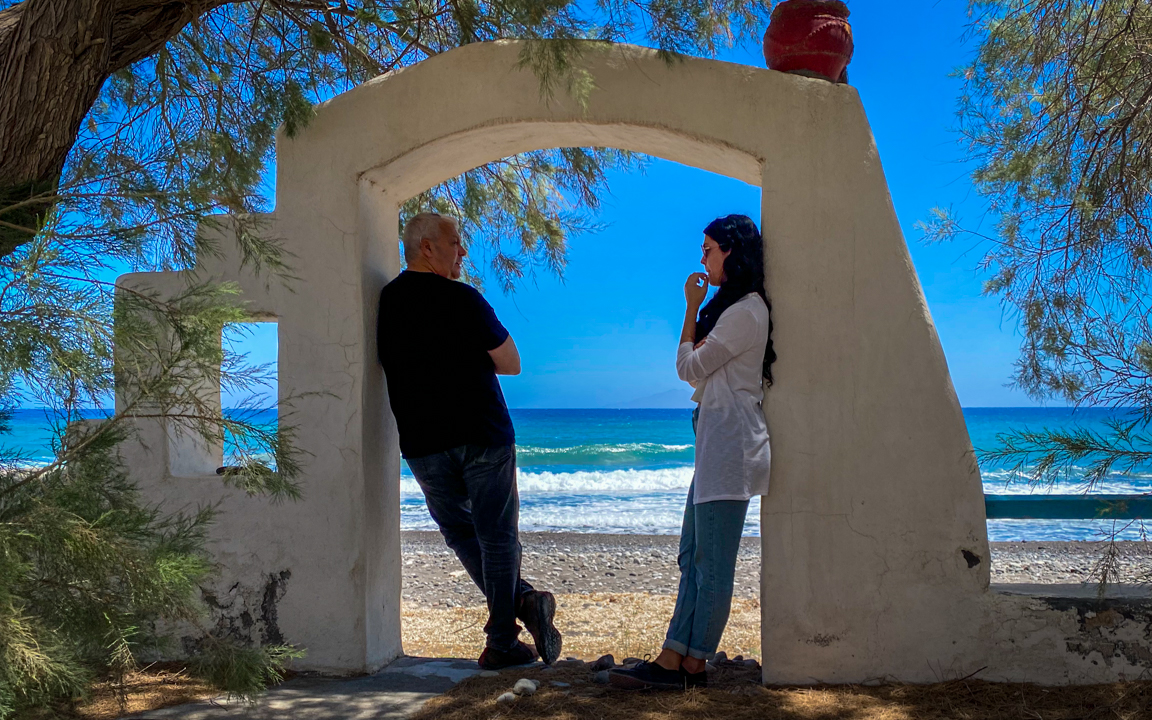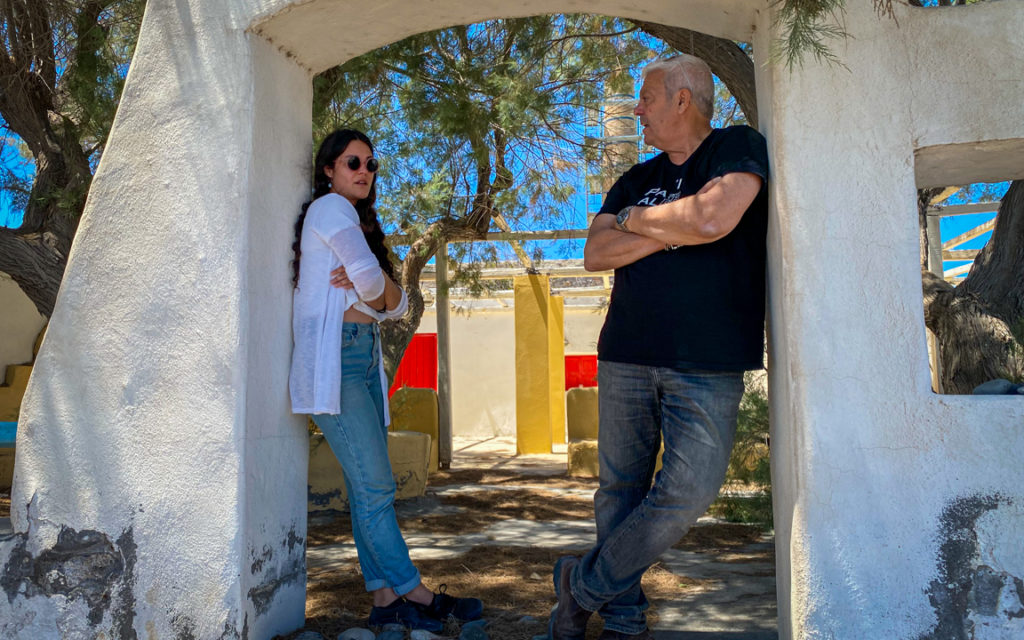
Underwater wines are not something wine aficionados usually think of when choosing a wine in Greece—or anywhere else. Giannis Paraskevopoulos, the co-founder of Gaia Wines on the Greek island of Santorini, and his daughter Lito, the assistant winemaker, produce unique wines that undergo a revolutionary new process of aging—underwater—in the crystal clear waters around Santorini.
The Greek islands, like all other islands all around the world, feature very creative and resilient people. The volcanic island of Santorini is no different. Greek Reporter is producing a series of ten stories on the people of the Greek islands called Humans of the Greek Islands. This is the second story in the series.
Thallasitis, the brand of Paraskevopoulos’ wine, means “the wine that comes from the sea.”
“This has been the brand of our wines since 1994,” the winemaker explains in an exclusive interview with Greek Reporter. “A friend who is a journalist had read an article about champagne that had been retrieved from a wreck somewhere in Finland, a bottle of champagne that had spent 170 years years under the waves, and this wine was still excellent.”

“So he said to me, ‘Yiannis, why don’t you try to age some of your Thalassitis wine under the sea to see how it goes?'” the winemaker relates.
“I saw in this idea an opportunity”
“In the beginning I thought of it as a stupid idea, to be honest—but then, [being] the scholar that I am, since I am a professor at the University—I saw in this idea an opportunity for an experiment. My daughter the chemist can probably better explain the biochemical dimension of this experiment,” he says.
Lito explains how she got into the business of fine wine making by saying “Our winery is right on the beach, as you can see here. At first I studied biochemistry; I didn’t have this kind of thing in mind at all. I came back to Greece after lot of years in the UK and I was looking for a job.”
“I wanted to give wine production a chance,” she states. After going to New Zealand and working a wine harvest there, she discovered that she was “just one pair of hands in a big factory. I didn’t really get a chance to know whether I liked it or not. So I gave it another chance at another Santorini vineyard, without the father factor,” she says as an aside.

“That did actually work really, really well and I ended up getting promoted to the second in command oenologist,” Lito said. “Then after working there for a year I came to Gaia and I have been here ever since.”
As Lito explains to Greek Reporter, there is fascinating science behind the secret of aging wines under the sea. “Basically, when you have a bottle of wine and it’s out in the open air,—I don’t care what kind of closures it has, whether a cork or a screw top—even if you have enclosed in in concrete, somehow, air is going to get in there,” she says.
“The difference is astounding” in underwater wines
“So when we talk about aging, automatically we’re talking about what that tiny bit of oxygen does to the wine….the idea is that in the water there is no oxygen in the form that can be absorbed into the wine, because it’s liquid,” Lito explains, and “[B]y aging the wines underwater, we are basically uncoupling the aging process from oxygenation. And that’s the experiment.”
“And true enough, the difference is astounding,” she declares. “And basically what happens is you get the best of both worlds—both aging and ‘young’ wines. So let’s say you have a wine that’s been mellowed out; it’s gotten ‘softer’ and more aromatic.”
“If you have wine that has aged above the water you get honey, flowers, more mature fruit flavors,” according to Lito. “In this case (when aged underwater) what happens is that its mineral character is encouraged—which is what happens with Assyrtiko anyway—but it is just boosted so much more.”
However, she adds, “that’s a bit transient, so when we open the bottle, it’s there for a bit and then it leaves and then you get all the floral notes…But at the same time, the wine is still ‘young’—you get all the color, it looks like it’s a few months’ old wine.”
Underwater wines are “Vibrant, tenacious, sharp”
“It’s very vibrant, very tenacious, very sharp, so it’s a weird combination of aged and not aged,” Lito tells us.
Asked by Greek Reporter about the wines’ saltiness, Lito replies “Yes, you do have a mineral character—even in wine that is not aged in salt water. But with the salt-water aged wines, you also get more of a smell of it, much more intensely than in wines that are aged on land.”
“The whole oxygen thing is very, very complicated and we still don’t know how exactly it happens, so it’s something that we need to look into,” she explains. “And that’s fun for us because we all dive and it’s just a really good story as well and it expresses us in every single way.”
Standing next to a large amphora that is nearly as large as she is, Lito says, “This was one of our experiments—still is. It started basically with us wanting to make wine, as far as we know how they used to make it, back in ancient times. Obviously, they didn’t have barrels back then, but they did have clay pots.”
“They obviously didn’t have the know-how that we have now, so it was very minimal. Just chuck in the grapes, leave them for a bit, take out the skins and then let it do its thing,” she said. “But this method didn’t work for us at first because the pots were too porous and they were actually ‘bleeding’ wine.”
“We let it do its thing”
“So then we decided to sort of ‘bring it home’ and use more modern means—but the philosophy is still the exactly the same—these (vessels) are also clay but they don’t bleed wine, so that’s a good thing,” said Lito.
“We take the grapes as they are, with the skins, and we let them start fermenting by themselves. After we judge by taste that it’s where we want it to be, in terms of ‘stiffness,’ a kind of tannic (flavor), we take out the skins and the stems and we let it do its thing,” Lito explained to us, adding that “the outcome is a darker white wine; it’s a bit orange, and it’s very tannic, like a red wine.”
“It dries your mouth out like a red wine,” the vintner explains.
“But the whole point is, whatever happens, it’s just because of the (grape) variety itself,” she adds. “We don’t use commercial yeasts—which is common practice everywhere. We just let the natural yeasts that exist on the grapes themselves just do their work, and whatever happens, happens.”
“And actually this year’s [wine] was very very good, very strong. at fifteen percent. At that point, it’s barely legally wine, and I like it like that,” Lito adds with a smile.
Name Thalassitis from as far back as 15th century BC
Gianni adds “We’ve been producing Thalassitis since 1994. It was the first label, the first vintage, that we ever produced on Santorini.”
Describing the word thallasitis, he says, “we got it from the Ancient Greek texts. It describes a wine that was produced in antiquity when ancient Greeks blended white wines with seawater for medicinal reasons. The writings go into great detail about how to go about getting the seawater in order to mix with the wine. So yes, this is a modern brand, it is our brand; but it comes from at least as far back as the 15th century BC.”
Lito adds, “I get asked a lot about that…because the wine is salty, they think that we also put seawater in the wine.” They most assuredly do not, they say—the natural saltiness comes from the atmosphere and what naturally occurs in the grapes themselves.
Giannis explains that: “There is a salty aftertaste in these wines because we are positioned on a small island that is battered by very strong winds, and the sea spray—although you don’t sense it…adds up everywhere. On the plants, on the vines, on the grapes and berries; so it’s an indirect addition of a sea element—salt—into our wine, which we can’t do anything about.”
“Having said that, this salinity does have a tremendous effect, in giving these wines a tremendous ‘food friendliness,” Giannis states. Lito interjects, adding that it adds a touch of a savory note to the wine.
“Absolutely!” Her father agrees. “The wines of Santorini achieve an appearance that you cannot possibly imagine. If I [were] asked to name the best pairing that you could achieve with Santorini wines, I would say try North Pacific oysters—or any oysters—with these wines. Provided they don’t come from the Canadian seas—but any ocean oysters from cold waters, with those wines…[are] just amazing!”
See all the latest news from Greece and the world at Greekreporter.com. Contact our newsroom to report an update or send your story, photos and videos. Follow GR on Google News and subscribe here to our daily email!



